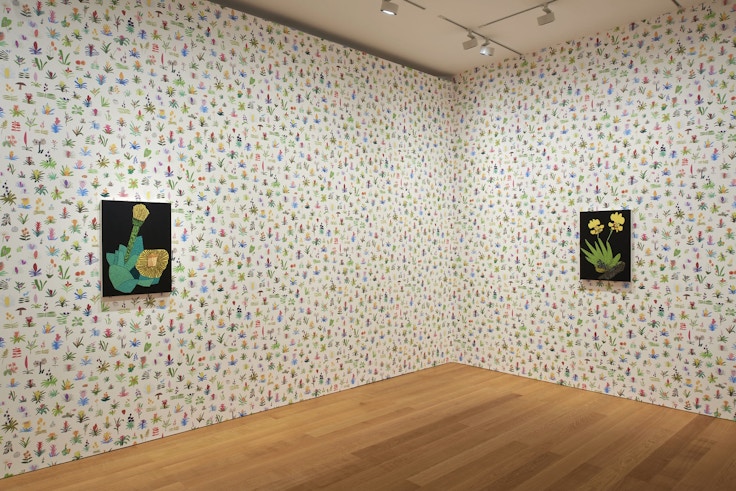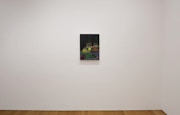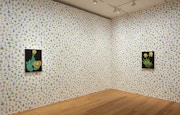ガゴシアン香港が、11月23日からアメリカ人アーティスト、ジョナス・ウッドの新作展を開催している。
ジョナス・ウッドは1977年にアメリカ・ボストンで生まれ、現在はロサンゼルスを拠点に活動しているアーティスト。果物や植物、器など様々なオブジェクトがある室内静物画を数多く手がけるいっぽう、自ら撮影/収集した写真を題材に、コラージュあるいは写真の上に直接絵を描く手法で作品を生み出してきた。東京・天王洲アイルにあるMAKI GALLERYには「ジョナス・ルーム」が設けられており、その代表作シリーズ「Tennis Courts」から24枚のドローイングや、テニスやバスケットボールをモチーフにした壁紙が常設展示されている。
香港の個展では、黒地のキャンバスに鮮やかな色の蘭や多肉植物、バナナ、モンステラなど様々な植物や静物が描かれた絵画を、ウッドが新たにデザインした花柄の壁紙の上に展示。そのキャリアにおいて重要なテーマのひとつである植物を媒介にし、色彩、パターン、線を探求する。
本展の開催に先立ち、ジョナス・ウッドにそのキャリアや制作プロセス、作風の変化などについて話を聞いた。

──画家であったあなたの祖父のコレクションにはアレクサンダー・カルダー、 フランシス・ベーコン、ロバート・マザウェル、 ヘレン・フランケンサーラーなどのアーティストの作品が含まれていました。 これらの作品に囲まれて育ったことは、ご自身のアートとキャリアにどのような影響を及ぼしましたか?
ジョナス・ウッド(以下、ウッド) 私は大学院に行って初めて美術史を勉強するまで、自分の周りにあったアートの力に気づきませんでした。
フランシス・ベーコンの重要性は理解していましたし、その作品から間違いなくエネルギーを感じることができました。作品の前に家族が立っている写真を見ると、その凄さを感じます。
大学院時代、私はおそらく何かしらの方法で自分に語りかけた偉大な芸術に囲まれていたのだということに気づかされました。アートのある環境で育ててくれた家族に感謝しなくてはなりませんね。
──ホバート・アンド・ウィリアムス・スミス・カレッジでは心理学を学んだ後、最終学年にペインティングを始めました。なぜこのような転向をしたのですか?
ウッド 4年制の大学で3年生までに専攻の履修をすべて終えました。心理学を専攻し、子供の発達と失読症について勉強していたのです。3年で勉強を終えたのち、ヨーロッパに行きました。
私はずっとアートをつくり続けてきたので、もっと勉強したいと思ったのです。ヨーロッパで失読症についての論文を書いていましたが、アートの勉強もしました。そこでたくさんのアートに触れ、絵の描き方を学びたいと決心したのです。

1年前にペインティングを教わった教授に連絡をとり、「独立したコースをつくってペインティングを学べないか」と聞きました。1999年、ペインティングについて真剣に考え始めたのはその頃でした。その1年後にはペインティングで応募した大学院に受かり、制作の実践をスタートさせました。
──2002年にワシントン大学を卒業後、ニューヨークやほかの都市ではなくロサンゼルスに引っ越すことにしたのはなぜですか?
ウッド ロサンゼルスを選んだのは、マット・ジョンソンに「ロサンゼルスに来い」と言われたからです。 私は東海岸のマサチューセッツ州の出身ですが、ニューヨークにもロサンゼルスにも住んだことはありませんでした。西海岸のシアトルの学校に通っていたのですが、東海岸に比べて少しゆったりした生活のペースが本当に好きでしたね。
マット・ジョンソンは私がロスに引っ越してきたときに知っていた唯一の友人であり、彼が「きっとうまくいくだろう」と言ったから引っ越したのです。

──ロサンゼルスに引っ越した当初は、ローラ・オーウェンスとマット・ジョンソンのアトリエでアシスタントとして働いていましたね。その経験はのちの作品にどんな影響を与えましたか?
ウッド マット・ジョンソン、ローラ・オーウェンス、そしてミンディー・シャペロのもとで働きました。
最初に働いたのがマットのアトリエで、当時からとても組織化されていて、助手を使っていましたね。 それからローラのもとで約2年間働きました。彼女からは、アトリエの運営方法からアート制作へのアプローチやアーティストとして生き方まで、いろんな意味で強い影響を受けました。
アトリエの運営や自分が望む働き方、そして自分にとって最高のアートをつくりだす方法について、2人とも私に大きな影響を与えてくれました。彼らのもとで働き、一緒に時間を過ごすことによって、彼らが各々の実践において、成功するための下準備をしてきたことがわかったのです。私も自分なりに成功すべく、学んだことを取り入れ、自分のために活用しようと努力しています。
──どのアーティストから影響を受けましたか? アンリ・マティスやデイヴィッド・ホックニーの作品と比較する評論家もいます。
ウッド いまはコンテンポラリーアートの影響をより受けているような気がしますね。私が若くて勉強していたころは、古い作品がずっと多かったのですが、いまは両方の組み合わせといったところでしょうか。
確かに、ピカソから影響は受けています。ファン・ゴッホ、モネ、マティス、ホックニーについて考えるとき、ぞれぞれのアーティストが描く線について考えるのです。エゴン・シーレの線はどんなものか?ジャコメッティの線はどんなものか?ヘンリ・ムーアの線はどんなものか?
そうやって自分の線、自分の声を探そうとするなかで影響を受けました。日常生活における何かを、自分の方法で描くのです。マティスとホックニーから大きな影響を受けたのは言うまでもありません。

──別のインタビューで、「写真からつくる」そして「そうした物事のコラージュをつくるか写真から直接つくるか」と言っていました。研究から作品の仕上がりまでの作業プロセスについて詳しく教えてください。
ウッド たくさんの写真を集めて、つくりたい様々なペインティングについて思いを巡らせます。ときには1枚の写真から、ときには自分で混ぜ合わせた大量の写真からです。
例えば、別々の写真から1個のリンゴ、子供の頃に撮ったオウムを、そして『ナショナル・ジオグラフィック』誌のなかで見つけた風景を組み合わせます。稀ではありますが、人から送られてきた写真を使うこともあります。
私は自分で写真を撮るか、インターネットで見つけた写真をスクリーンショットして印刷し、アトリエにピン留めしたりすることが多いです。ピン止めされた写真のアーカイブを持っている感じです。携帯で写真を撮り始めてから少なくとも8、9年経っているので、携帯のなかにはまだ印刷されていない大量の写真がありますね。デジタルカメラで撮ったことはありません。
ドローイングにもかなりの時間を割いています。1枚の写真から直接ドローイングを制作することもあれば、1枚のドローイングのなかにいろんなものを取り入れて、新しい視点を見出すこともあります。ときにはこうしたドローイングをモデルにしてペインティングをつくります。写真と複写以外モデルを使わないこともあります。いろんなものの組み合わせという感じです。アクリルと油絵具で一般的なものから特定のものまで描きます。

──室内空間やそのなかのインテリアに焦点を当てている作品が多いですが、なぜこのようなテーマに興味があるのでしょうか?
ウッド インテリアは私が何度も描きたいと思うペインティングの一種なのです。インテリアは通常、サイズが大きく、かなり複雑ですよね。様々なインテリアを描いたことがありますが、その空間は内部でありながら外部でもあり、窓がついています。尽きることのない、絵のアイデアの宝庫だと思います。
──別のインタビューで、近年の作品は「静物から、ペインティングから壷を取り出し、それからペインティングから巨大植物を取り出すこと」へシフトしたとおっしゃっています。ここ数年に起きたスタイルの変化を反映しているように思えます。過去20数年間のキャリアを顧みて、テーマとスタイルはどのように変化しましたか? またこうした変化についてどう見ていますか?
ウッド そうですね、まったく変化していないと思うときもあります。同じことを一番繰り返しているアーティストではないだろうかと。でも自分がやっていることをさらに改善しようと努力していると思いたいのです。
スタイルもペインティングへのアプローチも変わったと思います。しかし非常に似通ったペインティングのアイデアにいつも戻っている。ポートレート、静物、風景そしてインテリアです。ただテーマとしてはオブジェを描く方に関心が移りましたね。つまり固定された場所ではなく、ひとつのオブジェを描くことの方にです。
あとはペインティングからより多くのものを取り出すようになったのかなと思います。人々が気づいている以上に。

──「Tennis Courts」シリーズは代表作のひとつです。東京のMAKI Galleryで行っているコレクション展には「ジョナス・ルーム」があり、同シリーズからの素晴らしい作品や、テニスとかバスケの要素を描き込めた壁紙が展示されています。このシリーズを制作した背景は何ですか?

ウッド MAKI Galleryはこのテニスコートシリーズのドローイング24枚を所有しています。2018年、シカゴのシェーン・キャンベル・ギャラリーのために制作したものです。一緒に展示したい24枚でセットのドローイングであり、牧さんはこれらを非常に気前良く、世界で最高の美術館のひとつであるロサンゼルス・カウンティ美術館(LACMA)への贈り物として購入しました。それらが東京で展示されているのです。私の壁紙も展示されているので本当に嬉しいです。
「Tennis Courts」のシリーズはアトリエにあるテレビの写真を撮ることから始まったものです。縦型のフォーマットで制作していたので、そのかたちでのドローイングやペインティングとなりました。制作には5年〜6年かかり、その後シカゴでドローイングの連作として展示しました。

──バスケもペインティング作品のなかで繰り返し現れる要素ですが、なぜスポーツ要素に興味があるのですか?
ウッド スポーツが大好きだからですよ。人生で大好きなものを描いているだけです。
──11月23日から、ガゴシアン香港で新しい個展が開催されています。どんな作品が展示されているのでしょうか?
ウッド 黒の背景に植物や静物を描いたペインティングの新作と、花の壁紙の新作を展示します。ドローイングの作品群もいくつか出します。
──今後はどのようなテーマに取り組んでみたいですか?今後の予定はどんな感じですか?
ウッド 2022年1月22日からデビッド・コルダンスキー・ギャラリーで展覧会を開催します。植物や動物がたくさん出てくる予定です。

- 1
- 2






































